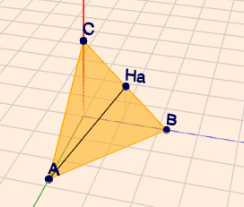Hallo Jibl,
Die IMHO einfachste Art, die Fläche zu berechenn läuft über das Kreuzprodukt \(AB \times AC\). In jedem Fall muss man wissen, wo die Eckpunkte \(A\), \(B\) und \(C\) liegen. Dazu setzt man in der gegebenen Gleichung zwei der drei Koordinaten =0 und berechet die dritte. Z.B. für \(x\):
$$4x + 5y + 5z - 11= 0 \quad y=0; \space z=0; \quad \Rightarrow x=\frac{11}{4}$$
Daraus folgen dann die drei Punkte \(A=(11/4;0;0)^T\), \(B=(0;11/5;0)^T\) und \(C=(0;0;11/5)^T\). Die Fläche ist dann
$$F =\frac12 \left| AB \times AC\right|=\frac12 \left| \begin{pmatrix} -11/4\\ 11/5\\ 0\end{pmatrix} \times \begin{pmatrix} -11/4\\ 0\\ 11/5\end{pmatrix} \right| \approx 4,915$$
Falls Du 'Kreuzprodukt' noch nicht gelernt hast, kann man sich hier auch zu Nutze machen, dass es ein gleichschenkliges Dreieck ist und der Mittelpunkt von \(BC\) gleich dem Höhenfußpunkt \(H_A\) ist.

Die Fläche ergibt sich dann aus
$$BC= \begin{pmatrix} 0\\ -11/5\\ 11/5\end{pmatrix} \quad \Rightarrow |BC| \approx 3,111$$
$$AH_A= \begin{pmatrix} 0\\ 11/10\\ 11/10 \end{pmatrix} - \begin{pmatrix} 11/4\\ 0\\ 0 \end{pmatrix} = \begin{pmatrix} -11/4\\ 11/10\\ 11/10 \end{pmatrix}\quad \Rightarrow |AH_A| \approx 3,160$$
$$F = \frac12 |BC| \cdot |AH_A| = \frac12 \cdot 3,111 \cdot 3,160 \approx 4,915$$